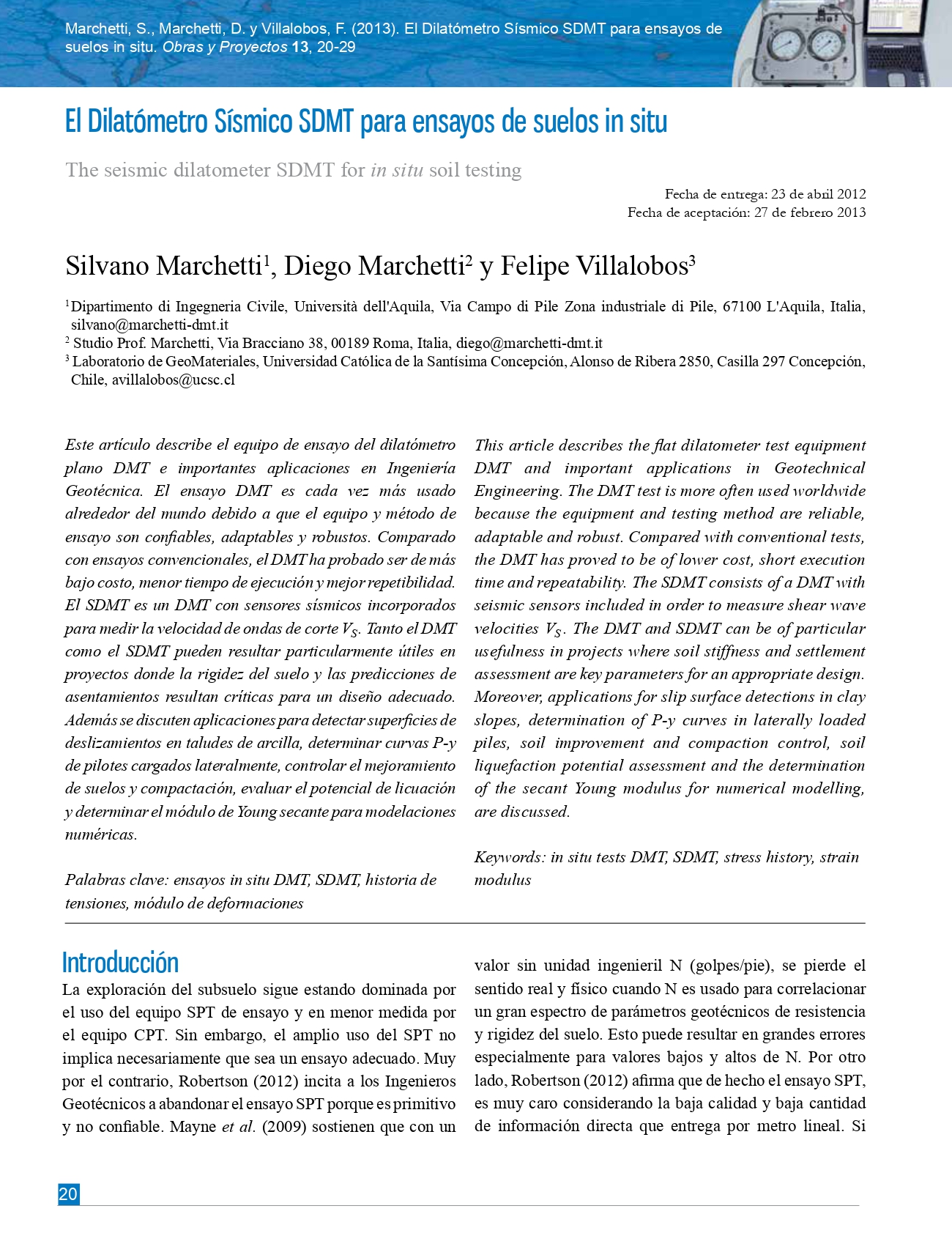El Dilatómetro Sísmico SDMT para ensayos de suelos in situ
DOI:
https://doi.org/10.4067/S0718-28132013000100002Palabras clave:
ensayos in situ DMT, SDMT, historia de tensiones, módulo de deformacionesResumen
Este artículo describe el equipo de ensayo del dilatómetro plano DMT e importantes aplicaciones en Ingeniería Geotécnica. El ensayo DMT es cada vez más usado alrededor del mundo debido a que el equipo y método de ensayo son confiables, adaptables y robustos. Comparado con ensayos convencionales, el DMT ha probado ser de más bajo costo, menor tiempo de ejecución y mejor repetibilidad. El SDMT es un DMT con sensores sísmicos incorporados para medir la velocidad de ondas de corte Vs. Tanto el DMT como el SDMT pueden resultar particularmente útiles en proyectos donde la rigidez del suelo y las predicciones de asentamientos resultan críticas para un diseño adecuado. Además se discuten aplicaciones para detectar superficies de deslizamientos en taludes de arcilla, determinar curvas P-y de pilotes cargados lateralmente, controlar el mejoramiento de suelos y compactación, evaluar el potencial de licuación y determinar el módulo de Young secante para modelaciones numéricas.
Referencias
Amoroso, S., Monaco, P. and Marchetti, D. (2012a). Use of the Seismic Dilatometer (SDMT) to estimate in situ G-g decay curves in various soil types. Proceedings of the International Conference on Geotechnical and Geophysical Site Characterization 4, Coutinho & Mayne (eds), Taylor & Francis, Vol. 1, 489 -497.
Amoroso, S., Lehane, B.M. and Fahey, M. (2012b). Determining G-g decay curves in sand from a Seismic Dilatometer Test (SDMT). Proceedings of the International Conference on Geotechnical and Geophysical Site Characterization 4, Coutinho & Mayne (eds), Taylor & Francis, Vol. 1, 447 -452.
Andrus, R.D. and Stokoe II, K.H. (2000). Liquefaction resistance of soils from shear-wave velocity. Journal of Geotechnical and Geoenvironmental Engineering 126, No.11, 1015-1025. https://doi.org/10.1061/(ASCE)1090-0241(2000)126:11(1015)
ASTM D6635 (2001, 2007). Standard Test Method for Performing the Flat Plate Dilatometer. Book of Standards, West Conshohocken, PA, USA.
Baldi, G., Bellotti, R., Ghionna, V, Jamiolkowski, M. and Pasqualini, E. (1985). Penetration resistance and liquefaction of sands. Proceedings ofthe 11th ICSMFE, San Francisco, vol. 4, 1891-1896.
Baligh, M.M. and Scott, R.F. (1975). Quasi Static Deep Penetration in Clays. Journal of the Geotechnical Engineering Division 101, No. 11, 1119-1133.
BSSC Building Seismic Safety Council (2004). NEHRP Recommended provisions for seismic regulations for new buildings and other structures. FEMA 450/451, 19-38.
Eurocode 7 (1997, 2007). Geotechnical Design - Part 2: Ground Investigation and Testing. EN 1997-2:2007.
Eurocode 8 (2004). Design of structures for earthquake resistance. Part 1: general rules, seismic actions and rules for buildings. EN 1998-1: 2004.
Hamza, M. and Richards, D.P. (1995). Correlations of DMT, CPT and SPT in Nile Basin Sediment. Proceedings 11th African Conference SMFE, Cairo Egypt, 437-446.
Hepton, P. (1988). Shear wave velocity measurements during penetration testing. Proceedings of Penetration Testing in the UK, ICE, 275-278.
Lee, M.J., Choi, S.K., Kim, M.T. and Lee, W. (2011). Effect of stress history on CPT and DMT results in sand. Engineering Geology 117 (3-4), 259-265.
Marchetti, S. (2010). Sensitivity of CPT and DMT to stress history and aging in sands for liquefaction assessment. Proceedings CPT 2010 International Symposium Huntington Beach, California.
Marchetti, S., Monaco, P., Totani, G. and Marchetti, D. (2008). In situ tests by seismic dilatometer (SDMT). Proceedings From Research to Practice in Geotechnical Engineering, ASCE Geotech. Spec. Publ. No. 180 (honoring J.H. Schmertmann), 292-311. https://doi.org/10.1061/40962(325)7
Marchetti, S. (1994). An example of use of DMT as an help for evaluating compaction of subgrade and underlying embankment. Internal Technical Note.
Marchetti, S., Totani, G., Calabrese, M. and Monaco, P. (1991). P-y curves from DMT data for piles driven in clay. Proceedings of the 4th International Conference on Piling and Deep Foundations, DFI, Stresa, Vol. 1, 263-272.
Marchetti, S. (1982). Detection of liquefiable sand layers by means of quasi-static penetration tests. Proceedings 2nd European Symposium on Penetration Testing, Amsterdam, vol. 2, 689-695.
Marchetti, S. (1980). In Situ Tests by Flat Dilatometer. Journal ofthe Geotechnical Engineering Division 106, No. 3, 299-321. https://doi.org/10.1061/AJGEB6.0000934
Marchetti, S. (1975). A New in Situ Test for the Measurement of Horizontal Soil Deformability. Proceedings of the Conference on In Situ Measurement of Soil Properties, ASCE Spec. Conf., Raleigh, Vol. 2, 255-259.
Mayne, P.W., Coop, M.R., Springman, S.M., Huang, A.B. and Zornberg, J.G. (2009). Geomaterial behaviour and testing. State of the art Paper. Proceedings of the 17th ICSMGE, Alexandria, Egypt, Vol. 4: 2777-2872.
Monaco, P., Marchetti, S., Totani, G. and Marchetti, D. (2009). Interrelationship between small strain modulus G0 and operative modulus. Proceedings of the International Conference on Performance-Based Design in Earthquake Geotechnical Engineering, Kokusho, Tsukamoto and Yoshimine (eds.), Tsukuba, Taylor & Francis, 1315-1323.
Monaco, P. and Marchetti, S. (2007). Evaluating liquefaction potential by seismic dilatometer (SDMT) accounting for aging/ stress history. Proceedings of the 4th International Conference on Earthquake Geotechnical Engineering ICEGE4, Thessaloniki, paper 1626.
Monaco, P., Marchetti, S., Totani, G. and Calabrese, M. (2005). Sand liquefiability assessment by Flat Dilatometer Test (DMT). Proceedings XVI ICSMGE, Osaka, vol. 4: 2693-2697.
Monaco, P. and Marchetti, S. (2004). Evaluation of the coefficient of subgrade reaction for design of multi-propped diaphragm walls from DMT moduli. Proceedings International Site Characterization ISC'2, Porto, Portugal.
NCh 433 DS 61 (2011). Diseño sísmico de edificios. Decreto 61. Reglamento que fija el diseño sísmico de edificios. Santiago, Chile.
Reyna, F. and Chameau, J.L. (1991). Dilatometer based liquefaction potential of sites in the Imperial Valley. Proceedings 2nd International Conference on Recent Advances in Geotechnical Earthquake Engineering and Soil Dynamics, St. Louis, 385-392.
Robertson, P.K. (2012). Interpretation of in-situ tests - some insights. The James K. Mitchell lecture. Proceedings of the International Conference on Geotechnical and Geophysical Site Characterization 4, Porto de Galinhas, Brasil, Coutinho & Mayne (eds.), Taylor & Francis, Vol. 1, 3 -24.
Robertson, P.K. and Campanella, R.G. (1986). Estimating liquefaction potential of sands using the Flat Plate Dilatometer. Geotechnical Testing Journal 9(1), 38-40. https://doi.org/10.1520/GTJ10610J
Robertson, P.K., Davies, M.P. and Campanella, R.G. (1987). Design of laterally loaded driven piles using the flat dilatometer. Geotechnical Testing Journal 12, No. 1, 30-38. https://doi.org/10.1520/GTJ10671J
Schanz, T. and Vermeer, P.A. (1997). On the Stiffness of Sands. Proceedings Symposium on Pre-failure Deformation Behaviour of Geomaterials, ICE, London, 383-387.
Schmertmann, J.H., Baker, W., Gupta, R. and Kessler, K. (1986). CPT/DMT Quality control of ground modification at a power plant. Proceedings of In Situ '86, Conference on Use of In Situ Tests in Geotechnical Engineering, Virginia Tech, Blacksburg, ASCE Geot. Special Publ. No. 6, 985-1001.
Schnaid, F. (2009). In Situ Testing in Geomechanics - the main tests. Taylor & Francis Group, London.
TC16 (2001). The Flat Dilatometer Test (DMT) in Soil Investigations. A Report by the ISSMGE Committee TC16. Reprinted in Proceedings of the 2nd International Conference on the Flat Dilatometer, 2006, Washington D.C., 7-48.
Totani, G., Calabrese, M., Marchetti, S. and Monaco, P. (1997). Use of in situ flat dilatometer (DMT) for ground characterization in the stability analysis of slopes. Proceedings XIV ICSMFE, Hamburg, vol. 1, 607-610.
Totani, G., Calabrese, M. and Monaco, P. (1998). In situ determination of Ch by Flat Dilatometer (DMT). Proceedings of the First International Conference on Site Characterization ISC '98, Atlanta, Georgia, USA, 883-888.
Totani, G., Monaco, P., Marchetti, S. and Marchetti, D. (2009). Vs measurements by Seismic Dilatometer (SDMT) in non penetrable soils. Proceedings 17th ICSMGE, Alexandria, Egypt, 2, 977-980. https://doi.org/10.3233/978-1-60750-031-5-977
Yu, H.S. (2004). In situ soil testing: from mechanics to interpretation. Proceedings 2nd International Conference on Site Characterization, ISC-2, Porto. vol. 1, 3-38.

Descargas
Publicado
Número
Sección
Licencia
Derechos de autor 2013 Universidad Católica de la Santísima Concepción

Esta obra está bajo una licencia internacional Creative Commons Atribución-NoComercial 4.0.







